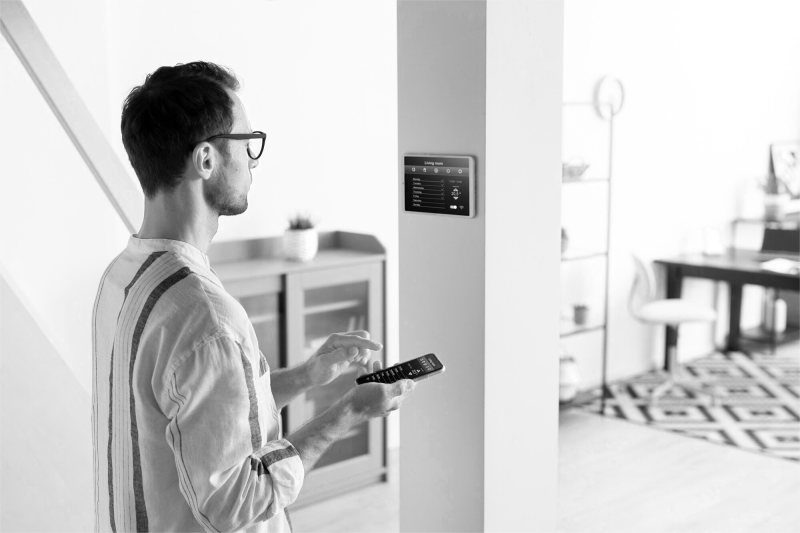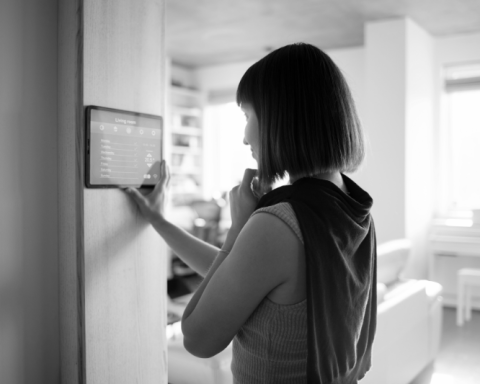Home security used to be pretty basic — a loud alarm system and maybe a camera or two. But these days, things have changed a lot.
Instead of just old-school alarm systems and grainy security cameras, the world now has smart, AI-powered home security systems that can do all kinds of amazing things. They can tell the difference between a real threat and your dog setting off the alarm again. And they can even recognize the faces of the people who live in your house, so you won’t have to worry about letting in the wrong person.
Despite these advancements, many people still don’t realize how advanced AI in home security systems has become today. But don’t worry, that’s where this handy guide comes in! It will break down all the incredible features and capabilities of AI in home security systems and show you just how accessible and affordable they can be.
Read on to learn how you can protect your home with the latest technology.
What AI in home security looks like
When you think about AI in home security, imagine smart systems that can actively protect your home rather than just react to threats.
These systems typically come as all-in-one solutions, combining hardware and software. You don’t just download an app or install camera software; instead, you choose specific brands and models equipped with built-in AI capabilities.
The demand for AI home security rides multiple consumer trends, such as AI and personalization.
To illustrate, a 2024 survey by Samsung suggests that consumers value personalization and security in AI home appliances, including home security systems. This means that consumers don’t just want a generic, one-size-fits-all security setup—they want something tailored just for them and their household. And these AI home security systems are delivering on that front.
These systems aren’t just passively recording footage or blaring alarms; they’re actively analyzing data, learning patterns, and making lightning-fast decisions to protect your home and family in ways that previous generation solutions simply can’t match.
Given these capabilities, the AI camera market is rapidly evolving. In 2023, its value was estimated at $7.8 billion, and analysts predict it will soar in the coming decade, potentially reaching $35.5 billion by 2034.
But how does all this benefit you? Here are the key components of AI in home security.
AI-powered security cameras and facial recognition
Nowadays, many security cameras on the market come equipped with advanced AI features. These cameras do more than just record footage; they use algorithms to detect and recognize faces.
How it works:
- Face detection. The camera captures images or video and uses deep learning algorithms to detect faces, focusing on key areas like the eyes, nose, and mouth.
- Feature mapping. Deep convolutional neural networks (DCNNs) extract a feature vector that represents facial characteristics, such as the distance between the eyes or the shape of the jawline, and create a unique “faceprint.”
- Comparison with stored data. This faceprint is compared to a database of stored faceprints using similarity metrics like “L2” or “cosine distance,” which are just specific measurements of certain areas of your face, to find matches.
- Recognition. If a match is found, the system identifies or verifies the individual; otherwise, it flags the face as unknown. The system can learn new faces over time to improve the accuracy.
These functionalities mean that these cameras can also analyze the situation and make intelligent judgments.
For example, when a delivery person approaches your door, the system can verify if they’re wearing an official uniform and carrying a package. If someone unfamiliar attempts to access your property during unusual hours, the system immediately flags this as suspicious behavior.
Real-time threat detection and response
AI in home security systems doesn’t just sit back and watch; it jumps into action when something’s up!
Some cameras on the market can spot sketchy loitering or package thieves. Many models even have features that actively monitor threats, alerting homeowners about unusual behavior.
And some of these systems will even take it a step further. They can automatically contact the authorities if they detect a break-in. No more waiting around, hoping someone will notice while strangers jeopardize your safety; this AI has your back.
It’s like having your own security guard, ready to act when trouble arises.
Predictive analytics and pattern recognition
These cameras and security systems don’t just react to trouble. They learn your routines to spot even the slightest anomaly. This involves several processes:
- Learning and remembering. These smart cameras don’t just watch — they learn your daily rhythm, from the 10 AM mail drop to kids bounding home at 3 PM, using cutting-edge AI like convolutional neural networks (CNNs) to map out what’s normal.
- Detecting and remembering patterns. Neural networks snoop through video to pinpoint routines, like clocking that daily delivery truck.
- Spotting unusual events. Some AI home systems detect anything offbeat — like a car lingering too long or someone sprinting through your yard — instantly, keeping you one step ahead.
- Future predictions. Uses vision transformers (ViTs) to forecast expected actions (e.g., a calm hallway stroll) and flags deviations (like if they bolt instead).
- Judging behaviors. Tags behaviors as “normal” or “suspicious” with support vector machines (SVMs), catching oddities like a crowd in a no-go zone.
- Always evolving. It adapts to your changing life, tweaking its data to stay sharp, whether your schedule shifts or new habits form.
Read more: Your Ultimate Guide to Home Safety While on Vacation
How regular people can use AI for home security
Implementing AI security doesn’t require a technical background or a massive budget. Modern systems are designed for everyday users while offering sophisticated protection. With the right tools and knowledge, anyone can enhance their home security effectively.
Here are the most important tips to consider when choosing an AI-powered security system:
Affordable AI-powered security systems
Quality AI in-home security systems kits start at under $200, making it doable for even the most budget-conscious to get in on the action.
When evaluating an AI security system, keep the following in mind:
- Identify important features. Determine which features are most important for your needs. If affordability is a priority, you may need to compromise on some advanced options.
- Assess long-term savings. Think about the potential savings in insurance premiums and the prevention of theft or damage, which can offset the initial investment.
Be sure to keep an eye out for these essential features:
- Facial recognition. These systems can distinguish between your trusted friends and family versus any sketchy strangers trying to sneak around.
- Motion detection. These smart sensors can distinguish between different types of movement, like people, pets, and vehicles. So you’re only getting alerts about the things that matter, not every squirrel wandering by.
- Cloud storage. Forget about cluttering up your space with expensive security hardware — the cloud’s got your back! Your recorded footage is stored safely and securely, and is easy to access whenever you need it.
- Smart home integration. Wouldn’t it be sweet to have your AI security system synced up with your other smart home tech? Imagine being able to control it all from one simple app or even with voice commands.
- Remote access. Speaking of apps, these systems usually have mobile options that let you monitor things from anywhere. So, even when you’re on the go, you can still check in and make sure your home or business is safe and sound.
When it comes to securing your home or business, affordable AI-powered security systems are not only possible but increasingly accessible.
Read more: Tech-Powered Tranquility With Smart Home Environments
DIY installation vs. professional setup
When deciding between DIY installation and professional setup for your AI security system, consider your comfort level with technology, your budget, and the complexity of your system.
Call in the pros if tech feels like a maze or your setup’s a bit complex. They’ll swoop in with expertise and ensure every camera and smart home connection is spot-on. They’ll also give you bulletproof security and total peace of mind.
But if you love diving into gadgets, DIY is your best course of action! Plus, most of these systems are built for ease — pop-up cameras, sync to WiFi, and tweak settings like motion detection or facial recognition with a few taps on a snazzy app. It’s fast, fun, and wallet-friendly, saving you big on installation costs.
Here’s how DIY usually goes:
- Follow the manufacturer’s instructions. They make it super straightforward, walking you through exactly where to place the cameras and how to connect everything to your home’s WiFi and the corresponding mobile app.
- Connect to your smart home tech. If you already have a bunch of other nifty smart gadgets, these AI security systems are often designed to seamlessly integrate so you can control them all from one handy app.
- Customize the settings. Tailor things like motion detection zones and facial recognition to hone in on what matters most for your specific home or business.
Integrating AI security with smart home devices
To create an effective AI-driven smart home security system, your devices must work together seamlessly. Follow these steps to ensure a smooth integration:
- Inventory your devices. Start by listing your existing smart home devices, such as cameras, lights, and voice assistants.
- Check compatibility. Verify their compatibility with popular AI security platforms like Ring, Google Nest, or Arlo by visiting the manufacturer’s website or using their app.
- Plan integration. Integration means connecting your smart home devices to an AI security system so they function as a cohesive unit. Decide which tasks you want to automate, such as locking doors at night or turning on lights when motion is detected.
- Test your devices. Confirm that your current devices support these automations, either through their apps or a central hub like Alexa.
Follow this checklist to finalize, secure, and check your AI security and smart home integration:
- Use strong, unique passwords and enable two-factor authentication.
- Update device firmware regularly to patch vulnerabilities.
- Disable unnecessary features (e.g., constant audio recording) to protect privacy.
- Set up automation rules (e.g., “If motion detected, turn on porch light”).
- Test voice commands and app controls to ensure smooth operation.
- Review AI alerts for a week to adjust sensitivity and reduce false positives.
In conclusion
Your home is more than walls and a roof — it’s the heart of your household. The place where you and your family feel the safest.
An AI-powered home security system isn’t just a high-tech upgrade; it’s a promise to protect your loved ones, your sanctuary, and your peace of mind. These smart systems weave your devices into a vigilant guardian that watches over your family 24/7, adapting to your life with effortless automation and control.
Whether you’re a tech-savvy DIYer piecing together a budget-friendly setup or leaning on pros for a fortress-like system, there are now plenty of AI-powered solutions. This article offers clear steps to choose, set up, and maintain a system that protects your home.
Take that first step today. Explore a device. Build a fortress of love and security for your home.
If you want to see more resources on home security, check out the Household Management Science Labs. The lab uses the research of the Institute for Life Management Science to produce courses, certifications, podcasts, videos. and other tools. Visit the Household Management Science Labs today.
Photo by Freepik



